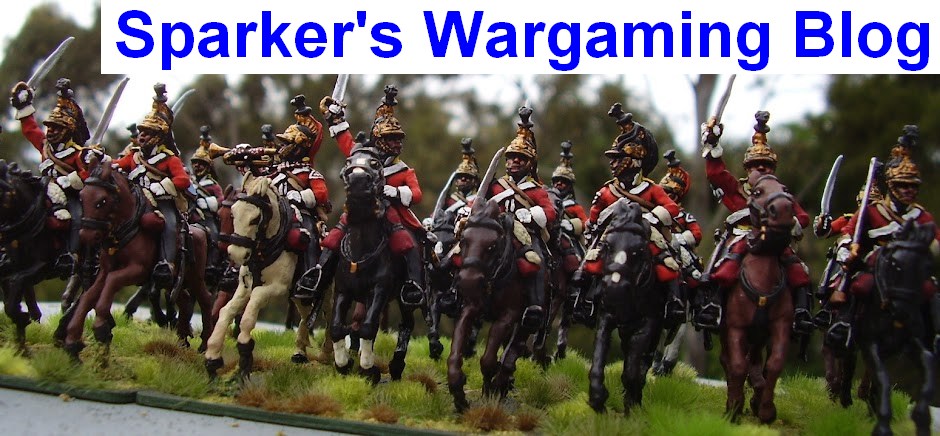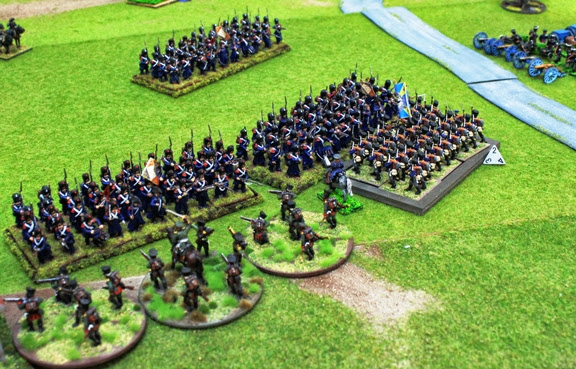We used 4,000 28mm figures and played over 144 square feet of gorgeous terrain.

Of course the actual Battle of Leipzig was too huge even for model megalomaniacs like us to attempt to replicate wholesale. It was the largest battle in recorded history to date, and was fought over 3 days over a huge area. Truly it earned its title of ‘Battle of the Nations’!

Instead we concentrated on replicating just one aspect of the fighting – that which occurred in the South Western sector on the 16th October on the Wachau ridge. For wargamers this action if of interest because you can mix up the armies from several nationalities – for the Coalition allies, Austro Hungarians fought alongside Prussians and Russians, whilst French, Poles and Saxons all fought for Napoleon.
But as well as being a colourful action, it is also very dynamic, and can easily be broken down into 3 distinct phases. First the Allies, principally Prussians and Russians, launched a somewhat disjointed offensive against the Wachau ridge, failing to coordinate properly with the main Austrian forces….


Of course, Napoleon was not long in spotting this, and, having his Imperial Guard and Cavalry Reserve to hand, seized the opportunity to launch and effective counter attack. Well, historically, the Infantry of the Guard were effective, Murat’s cavalry less so…
 |
| Auenhayn. Scratch built by Jim and Sons. |
In any case the main Austro Hungarian Reserve formations turned up to stablilise the front for further exploitation the over the next days…but not the concern of this game, some other time perhaps!
Designing the scenario threw up some challenges. I wanted to force the action to follow the 3 phases, but retaining a strong element of free play. I therefore came up with a set of Victory Conditions that combined the standard Objective holding with an element of gaining victory by attrition. However in the previous Dennewitz game this all came to nought as players were reluctant to aim for victory by destroying enemy units since they might themselves lose units, and therefore points, in the process…
Victory Points by Attrition:
|
Victory Points by Capturing Ground:
| |||||||
Move
|
Theme
|
Allies to gain
|
French to gain
|
Notes
|
Location
|
No. of ‘Blocks’
|
Garrison
|
VPs when taken
|
1-4
|
Allies attack
|
1 per formed unit destroyed
|
Allies not penalised for lost units
|
Markleeberg
|
1 bn ea block
|
2 ea block
| ||
5-8
|
Fr counter attack
|
1 per formed unit destroyed
|
French not penalised for lost units
|
Wachau
|
3
| |||
9-10
|
Austrians Stablilise
|
1 per formed unit destroyed
|
1 per formed unit destroyed
|
Crostewitz
|
1
|
2
| ||

The main point to note is that during either side’s attacking phase of 4 moves, they are were penalised for their own losses. This was designed to encourage aggression and plenty of manoeuvre a l’outrance!

Thanks to great work by the Hall of Heroes team and Terry, who is becoming something of a terrain and layout guru, when we arrived bright and early the landscape representing the environs of Wachau was beautifully laid out and deployment cards laid out to aid the process of laying out thousands of model troops. It only remained for the team briefs. Quite deliberately the Coalition command structure was vague and fractured, to represent the difficulties of Coalition command and the interference from the various Monarchs on the field. However by contrast the homogenous nature of the French army was well represented by a clear and focussed brief from Phil as the French Commander.
 As the players started to deploy, it was disappointed to see much use of line formation by those not familiar with the 1813 campaign. I often think that Napoleonics would benefit from the clear distinction that Flames of War has given WW2 gaming by dividing it into Early, Middle and Late War, since the players could not be persuaded that the use of line by hastily raised and trained conscript battalions, in the open, would have been rare, to say the least. I resorted to declaring that conscript troops deployed in line would be deemed Shaken, and so subject to Break tests if they received casualties. A little drastic perhaps, but it seemed to encourage more historical deployment.
As the players started to deploy, it was disappointed to see much use of line formation by those not familiar with the 1813 campaign. I often think that Napoleonics would benefit from the clear distinction that Flames of War has given WW2 gaming by dividing it into Early, Middle and Late War, since the players could not be persuaded that the use of line by hastily raised and trained conscript battalions, in the open, would have been rare, to say the least. I resorted to declaring that conscript troops deployed in line would be deemed Shaken, and so subject to Break tests if they received casualties. A little drastic perhaps, but it seemed to encourage more historical deployment.
As the action opened, it was only really in the middle third of the table that the Prussians, under Jason, with Command values as good as the French ones, launched the all-out aggressive attacks that the Allies needed to take advantage of their ‘offensive phase’. On either flank, the lower command values of the Russians and Austrians hampered movement, and on the far Western flank the swampy ground around the Schaukelgraben, which reduced Infantry and Cossack movement by half, and was impassable to heavier cavalry, added to the delay and frustrations experienced by Russian commanders here, Bryan and Austin. The beaten zone of the French Grand Battery was also murderous to the masses of Allied Cavalry unfortunately deployed to its front. Over on the Eastern flank Jim's Austrian light cavalry soon had the French Infantry pinned into square, but once again the poor Austrian Command values meant that getting the Infantry up to take advantage was problematic.
However the Coalition team struggled manfully on, and on move 4, the last move of their offensive phase, they started to reap the reward, with 4 French units being destroyed, and the Prussians launching determined attacks on Wachau. These were initially rebuffed by the defenders in the strong stone building of this town, with +2 to their morale saves, but in the next move persistence paid off, and the 2nd Silesian Fusiliers stormed into the Eastern half of Wachau, earing the Coalition 3 Victory Points. With another French unit destroyed, as well as the garrison, this meant that the Coalition attacking phase ended with a total of 8 Victory points.
At this stage it was becoming clear that we would not have time to complete all 3 of the planned phases of the game. In a sense as a wargaming group, we are victims of our own success, attracting new blood all the time, which is great, but of course inexperienced players, no matter how enthusiastic, can slow things down. It was agreed with both teams that we would simply play to move 8, omitting the third Coalition Consolidation phase, when the bulk of the Coaltion Reserves and Guards would have arrived.
So at this stage, it was the French turn to take the offensive, representing Napoleon sensing that the Allies had shot their bolt, and now was the time to commit the Reserve Cavalry, and then the Guard, to seize the initiative and take advantage of the failure of the Coalition to consolidate their overwhelming numbers – entirely as a result of the scenario conditions, of course, not the fault of the coalition team!
It is rare in historically based scenarios for players to get to commit both the Old and Young Guard, and the mass of Reserve Cavalry Cuirassiers, so it was with a certain amount of relish that Phil unleashed the dark blue wave!
Whilst the Heavies made good progress in taking on what remained of the Coalition cavalry, and Terry and Vic were leading the Young Guard in a dangerous looking advance on the Western Flank towards Crostewitz, the attempts by the Old Guard to retake Wachau were rebuffed by the stout Prussian defenders.
However more generally across the Western and Central portion of the field the French and Poles were getting stuck in, and over on the Eastern Flanks forces from Troy's V Corps were effectively interdicting Coalition efforts to redeploy around the swampy ground. As a result of a well-coordinated and bold series of French assaults Coalition units were being destroyed all over the place, so that in no time the French team and met and exceeded the Coalition Victory Points tally.
At move 7, more in defiance than expectation of victory, Richard duly started to bring on the Austrian Reserves, with an outside chance of capturing Markleeburg with its 3 Victory Points. However the curse of low Coalition Command Values meant that his daring and aggressive orders failed, and he had to content himself with stabilising the sector.
The Coalition team can take pride in the fact that they seized half of Wachau, and despite the continued efforts of Napoleon’s finest, held onto it throughout the game. Also worth a mention in despatches I think are the gallant 1st Silesian Landwehr Battalion, who were somehow able to destroy a unit of the Old Guard!
So all in all the game played out fairly historically, with the initial Coalition assaults frustrated by a disjointed approach (represented by an unpromising table deployment) and poor staff work (low command values); whereas the French were able to capitalise on Napoleon’s presence (Command value of 10) and having strategic holy trinity on hand – the Guard Grand Battery, Cavalry Reserve, and Old and Young Guard corps.
Lessons learnt? If we were to replay the scenario, I would probably lengthen the Coalition assault phase to 5 or 6 moves, or perhaps reduce the impact of the swampy ground to make more of a game of it for the Coalition team.
But all in all an enjoyable and spectacular looking game, and a suitable commemoration of the 200th anniversary of the ‘Battle of the Nations’…












.jpg)
Brilliant looking game!
ReplyDeleteFantastic looking battle in overview and also the close up detail! Wonderfully painted troops on great looking terrain - doesn't get any better!
ReplyDeleteGreat job, great looking battle.
ReplyDeleteJohn
Enough eye candy to turn you into an ocular diabetic, the layout for this one-day tribute to Leipzig is superb. Great table, I particularly like the buildings, and a terrific array of beautifully presented minis, all in 28mm. Well done indeed!
ReplyDeleteCaesar
sensational looking game.
ReplyDeleteGreat report, thanks from a fellow meglomaniac
ReplyDeleteA great report for a great battle....very nice looking game, I like your cavalry units...Beautiful, huge, table!
ReplyDeleteVery impressive sight!!
ReplyDeleteGreat report mate and a great day! I shall always cherish the memory of my landwehr seeing off an old guard battlion! Of course I plan to boast about that one for the rest of my life!!! Thanks for organising the day Sparker, as always a fun day with great people!!
ReplyDeleteGreat report and lovely photos. A real achievement to stage a battle of this size in 28mm
ReplyDeleteImpresive, thanks for sharing!
ReplyDeleteGreat game Gents, impressive collection, beautifully painted figures, great terrain, and a respectful and fun way to commemorate the bicentennial of Leipzig. I wish I lived in Oz (I should have followed my GP!!!)
ReplyDelete